Measure, Monitor and Improve Safety Culture
The safety culture index allows organisations to capture employee perception of safety to identify safety culture maturity.
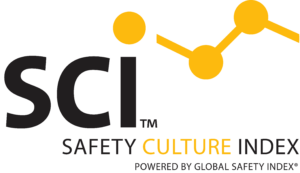
The importance of measuring safety culture
The Safety Culture Index helps you measure what really matters—how your people think and feel about safety.
It gives you data to benchmark performance, identify gaps, and track change over time.
Whether you lead a site, a business unit or a whole organisation, it’s a practical way to turn culture into something visible, trackable and actionable.
Most safety programs focus on compliance and lag data. According to Safe Work Australia, safety culture is a key factor in managing both physical and psychosocial risks.
If you're not measuring it, how can you improve it?
What is the safety culture index?
The SCI is a comprehensive multi-category survey tool used by over 64,000 users and approximately 4 million data points, making it the worlds largest safety culture and leadership database.
With 56 questions covering 9 dimensions and 14 culture key drivers, It is designed to be a tool that provides a granular level of detail of an organisations safety culture that can be as broad or as a deep as required and provide targeted insights to influence an organisations strategic planning.
Employers are provided with a simple to navigate dashboard that can be incorporated with management and board reports along with a comprehensive report.

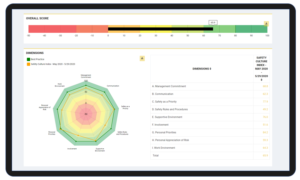
What does the safety culture index cover?
- Management Commitment – Perceptions of management’s overt commitment to health and safety issues
- Communication – The nature and efficiency of health and safety communications within the organisation
- Priority of Safety – The relative status of health and safety issues within the organisation
- Safety Rules and Procedures – Views on the efficacy and necessity of rules and procedures
- Supportive Environment – The nature of the social environment at work, and the support derived from it
- Involvement – Extent to which safety is a focus for everyone and commitment to being actively involved
- Personal Priorities – The individual’s view of their own health & safety management & need to feel safe
- Personal Appreciation of Risk – How individuals view the risk associated with work
- Physical Work Environment – Perceptions of the nature of the physical environment
- Attitudes to specific safety related systems and procedures (for example, permit to work systems) can be included as necessary.
- In addition to the 56 comprehensive questions, members have the ability to ask additional custom custom questions as part of the survey
What does the safety culture index cover?
- Management Commitment – Perceptions of management’s overt commitment to health and safety issues
- Communication – The nature and efficiency of health and safety communications within the organisation
- Priority of Safety – The relative status of health and safety issues within the organisation
- Safety Rules and Procedures – Views on the efficacy and necessity of rules and procedures
- Supportive Environment – The nature of the social environment at work, and the support derived from it
- Involvement – Extent to which safety is a focus for everyone and commitment to being actively involved
- Personal Priorities – The individual’s view of their own health & safety management & need to feel safe
- Personal Appreciation of Risk – How individuals view the risk associated with work
- Physical Work Environment – Perceptions of the nature of the physical environment
- Attitudes to specific safety related systems and procedures (for example, permit to work systems) can be included as necessary.
- In addition to the 56 comprehensive questions, members have the ability to ask additional custom custom questions as part of the survey
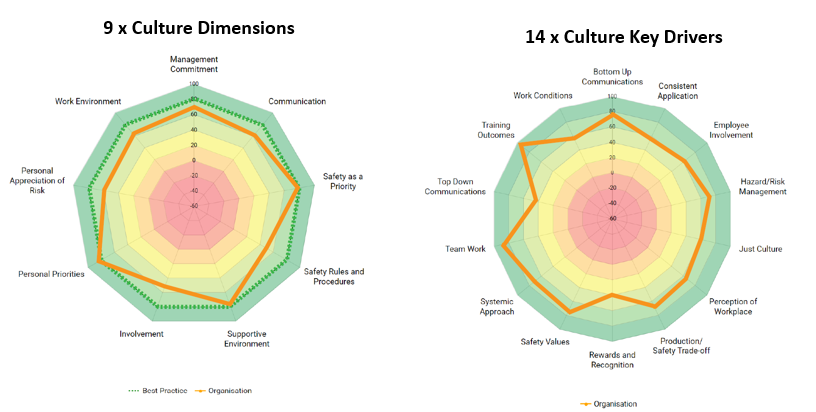

Identify and analyse 'cause and effect'
Real time tracking of organisation safety culture provides insight into organisational strength and weakness, enabling a focused approach to allocate time, resource and energy to to improve performance.
The SCI provides you the ability to answer “How is our Culture impacting our performance”?
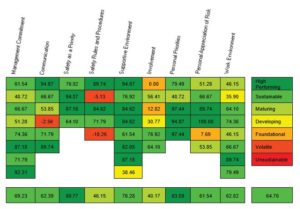
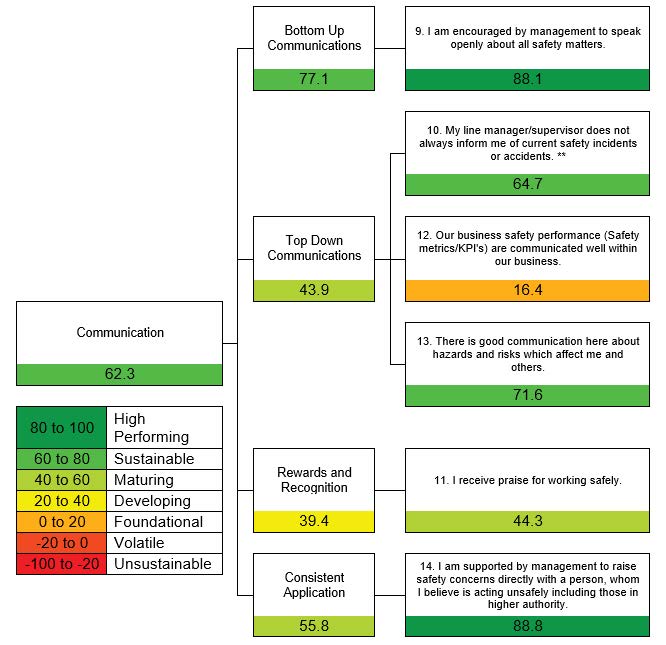
INSTANT comprehensive report
GSI Safety Culture Index Report provides a detailed view on your organisations performance that is available immediately following your survey close date. The reports are based on the structure that is built, so there are no additional charges to deep dive into different departments or locations.
The report is structured to provide granular and anonymous insights into specific areas of your organisation.
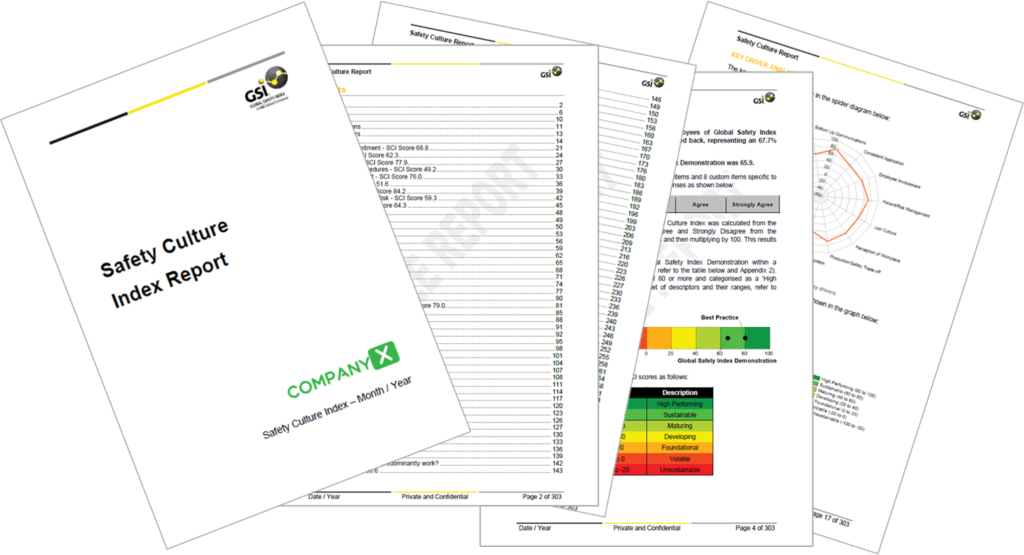
How it works
Start with the end in mind (How will I use the data? Who will want to know about specific areas etc). Make a commitment to act on the results.
Communication is critical to good engagement. Develop comms to be released 2 weeks ahead of the launch of your survey.
Login to your GSI portal and set up your structure and culture survey
Decide if you want anonymous, token invites or a hybrid of both.
Launch the Safety Culture Index.
Individuals can complete their SCI from any device and progress can be monitored live from the dashboard
Once the survey closes, a comprehensive report will be immediately available to review.
A detailed analysis of the report will provide insights to help improve organisational performance.
Present the findings back to your executive team and develop a strategic plan to improve or maintain your safety culture.
Repeat your culture survey to monitor the effectiveness of change.
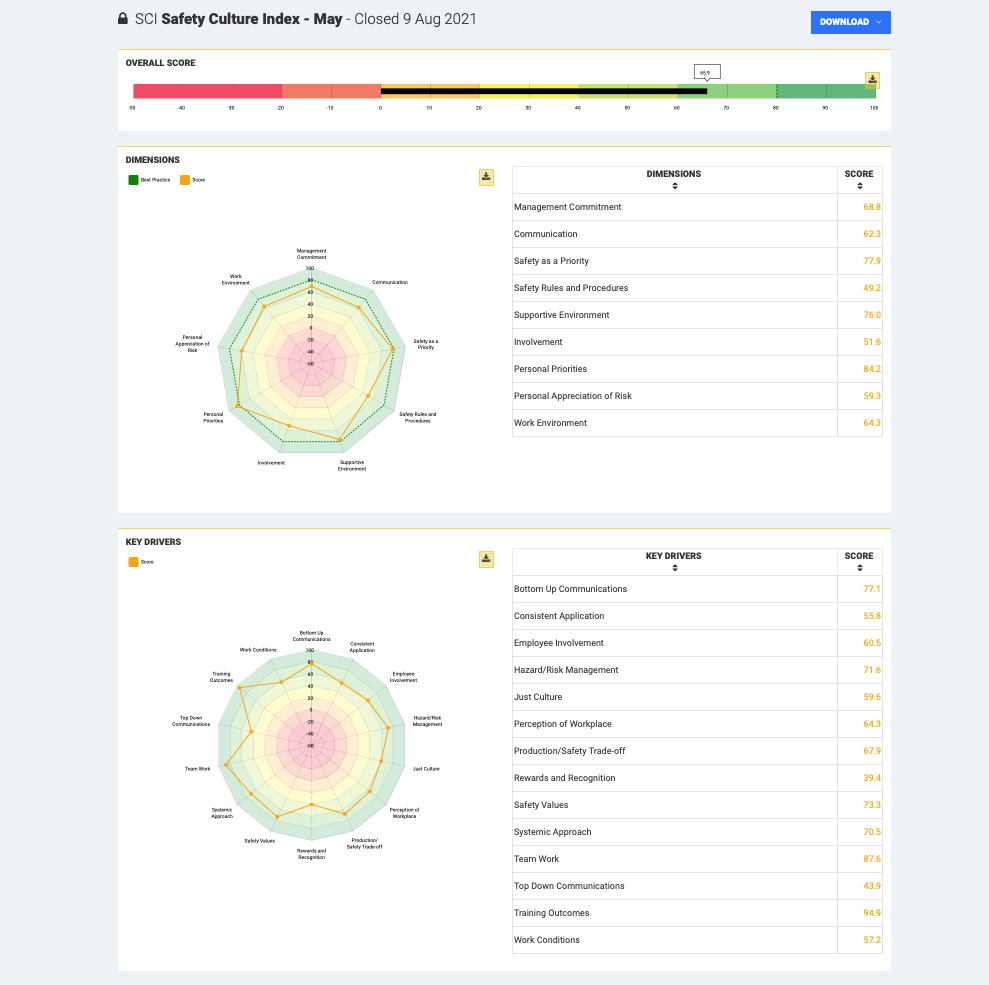
Monitor your organisation's responses by Key Dimensions
Monitor your overall culture score via survey dashboard view.
See specific progress on 14 key drivers.
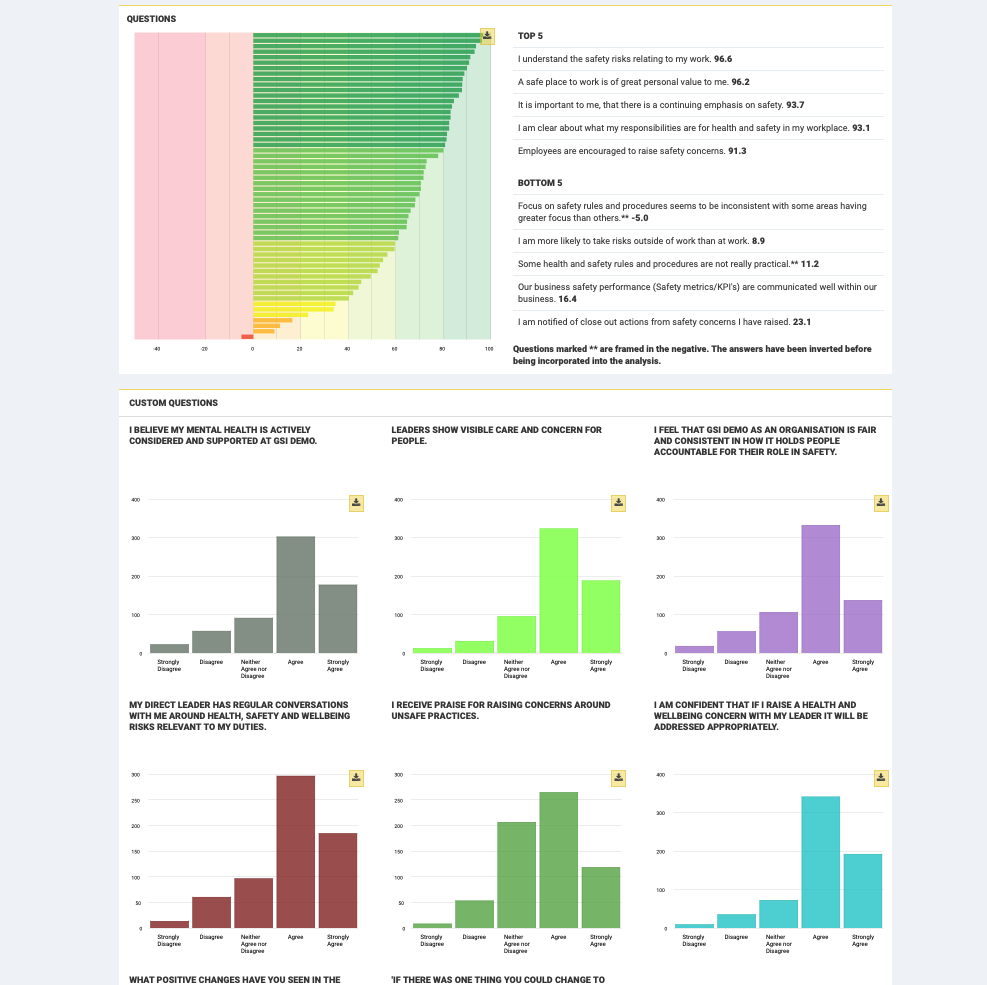
Quickly identify your top 5 / bottom 5 improvement areas direct in your dashboard.
Measure responses to custom questions
Available in 57 Languages!
All language translations have been completed by an independent certified organisation to ensure the original intent of the questions are maintained. If you do not see your language listed here, please reach out and we can have it added.
|
Afrikaans (South Africa) Afrikaans (Suid-Afrika) |
Amharic (Ethiopia) አማርኛ (ኢትዮጵያ) |
Arabic (Egypt) العربية (مصر) |
Bengali (Bangladesh) বিএন-বিডি বাংলা (বাংলাদেশ) |
Bengali (India) বাংলা (ভারত) |
Bulgarian (Bulgaria) български (България) |
|
Chinese (Simplified, China) 中文(中国) |
Croatian (Croatia) Hrvatski (Hrvatska) |
Czech (Czechia) Čeština (Česko) |
Danish (Denmark) Dansk (Danmark) |
Dutch (Belgium) Nederlands (België) |
Dutch (Netherlands) Nederlands (Nederland) |
| English (United States) |
Estonian (Estonia) eesti keel (Eesti) |
Filipino (Philippines) Filipino (Pilipinas) |
Finnish (Finland)
Suomi (Suomi) |
French (Belgium) Français (Belgique) |
French (Canada) Français (Canada) |
|
French (France) Français (France) |
German (Germany) Deutsch (Deutschland) |
Greek (Greece) Ελληνικά (Ελλάδα) |
Hindi (India) हिन्दी (भारत) |
Hungarian (Hungary) Magyar (Magyarország) |
Icelandic (Iceland) Íslenska (Ísland) |
|
Indonesian (Indonesia) Bahasa Indonesia (Indonesia) |
Italian (Italy) Italiano (Italia) |
Japanese (Japan) 日本語 (日本) |
Kannada (India) ಕನ್ನಡ (ಭಾರತ) |
Khmer (Cambodia) ភាសាខ្មែរ (កម្ពុជា) |
Korean (Korea) 한국어 (대한민국) |
|
Latvian (Latvia) Latviešu (Latvija) |
Lithuanian (Lithuania) Lietuvių (Lietuva) |
Malaysian (Malaysia) Bahasa Malaysia (Malaysia) |
Maori (New Zealand) te reo Māori (Aotearoa) |
Marathi (India) मराठी (भारत) |
Myanmar (Myanmar) ဗမာဘာသာစကား (မြန်မာ) |
|
Norwegian (Norway) Norsk (Norge) |
Persian (Iran) فارسی (ایران) |
Polish (Poland) Polski (Polska) |
Portuguese (Brazil) Português (Brasil) |
Romanian (Romania) Romana (Romania) |
Russian (Russia) Русский (Россия) |
|
Samoan (Samoa) Gagana faʻa Sāmoa |
S’gaw Karen (Myanmar) ကညီကျိာ်အခီၣ် |
Slovak (Slovakia) Slovenčina (Slovensko) |
Slovenian (Slovenia) Slovenščina (Slovenija) |
Spanish (Latin America) Español (Latinoamérica) |
Spanish (Spain) Español (España) |
|
Swahili (Kenya) Kiswahili (Kenya) |
Swedish (Sweden) Svenska (Sverige) |
Telugu (India) తెలుగు (భారతదేశం) |
Thai (Thailand) ไทย (ประเทศไทย) |
Turkish (Türkiye) Türkçe (Türkiye) |
Ukranian (Ukraine) українська мова (Україна) |
|
Vietnamese (Vietnam) Tiếng Việt (Tiếng Việt) |
Xhosa (South Africa) isiXhosa (uMzantsi Afrika) |
Zulu (South Africa) isiZulu (iNingizimu Afrika) |
Book a demo
Book a demonstration to see the full functionality and capability of GSI!
By submitting your contact details you agree that Global Safety Index may contact you regarding offers, updates, and other marketing messages in accordance with our privacy policy.
